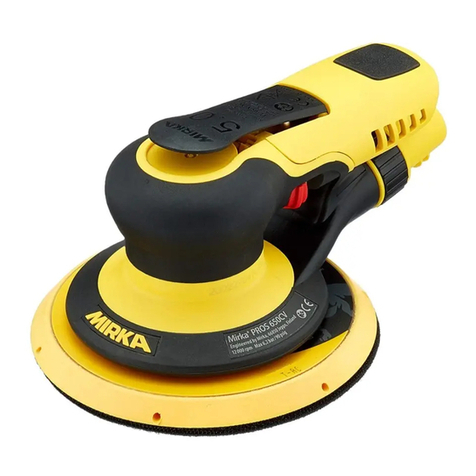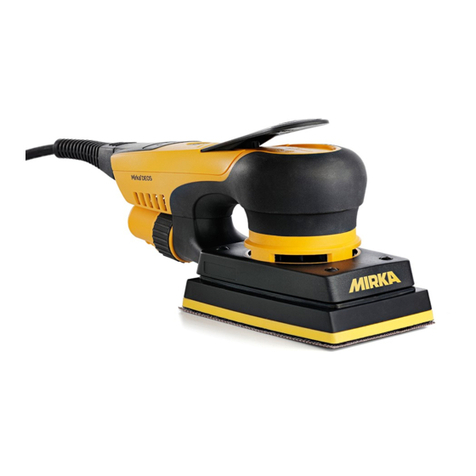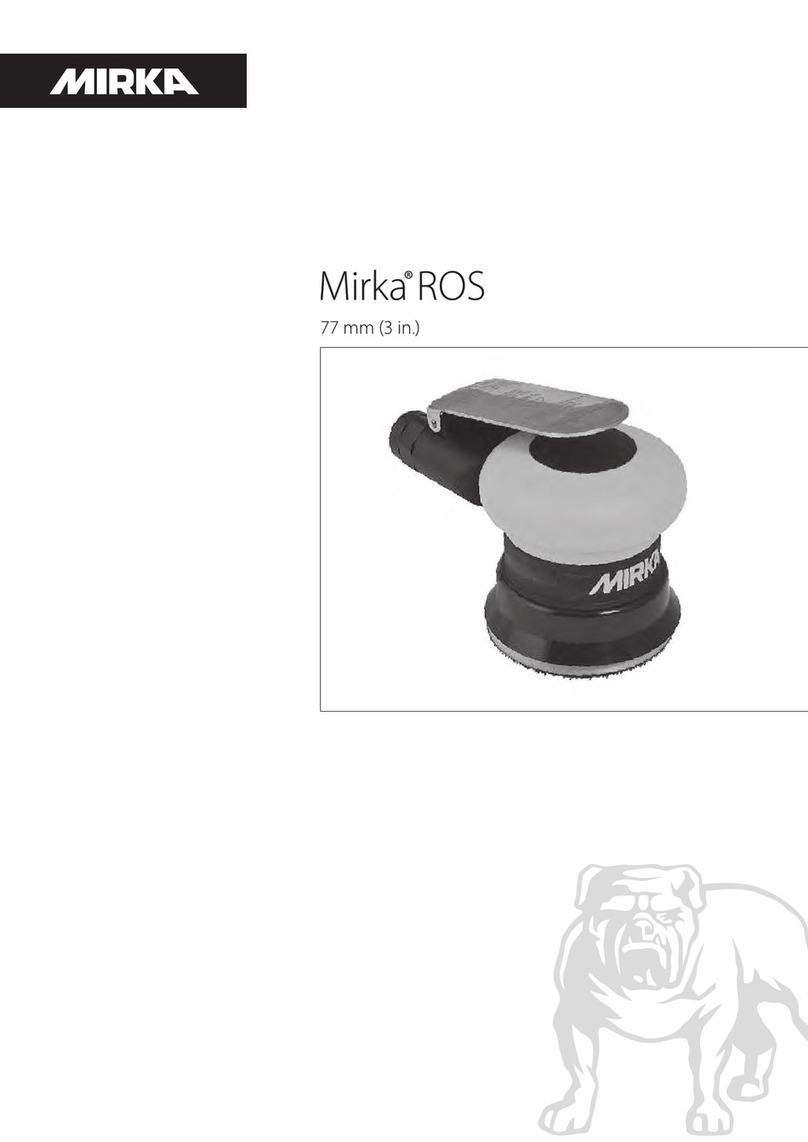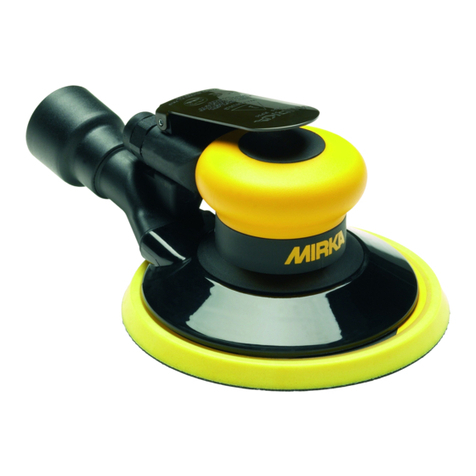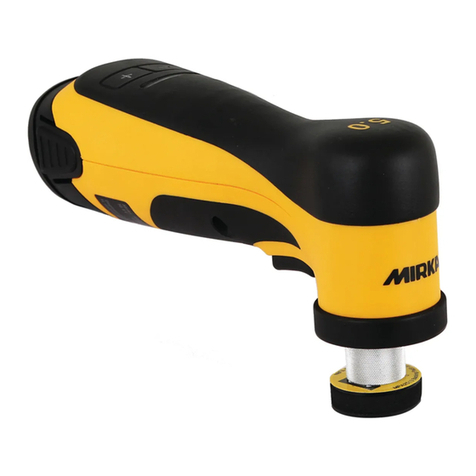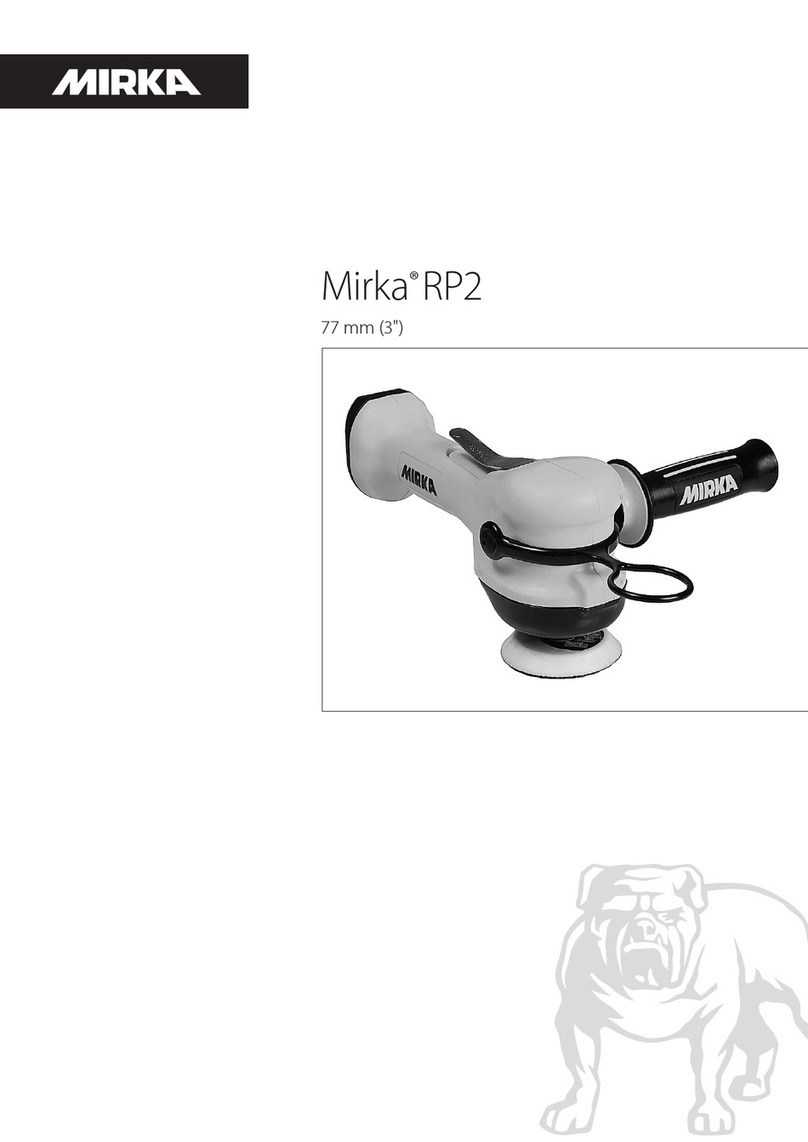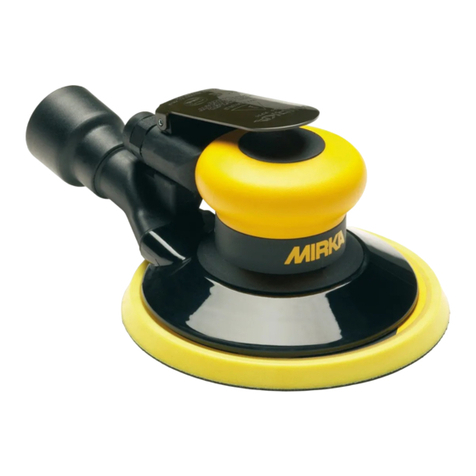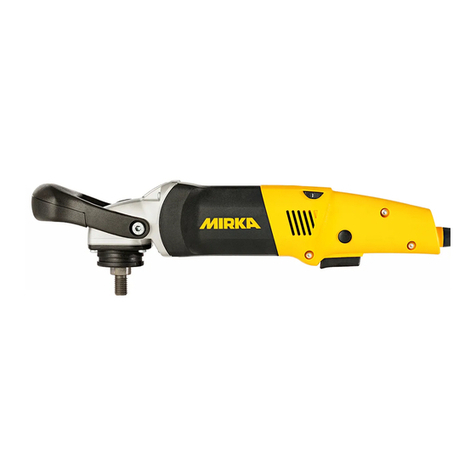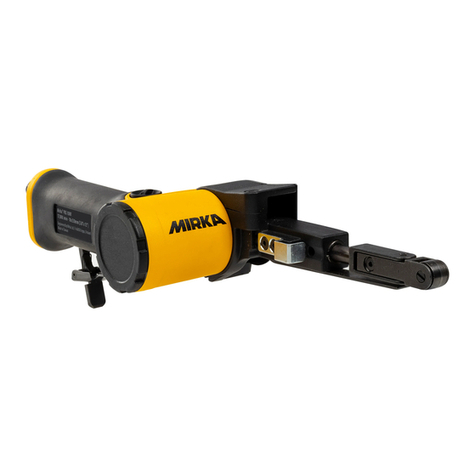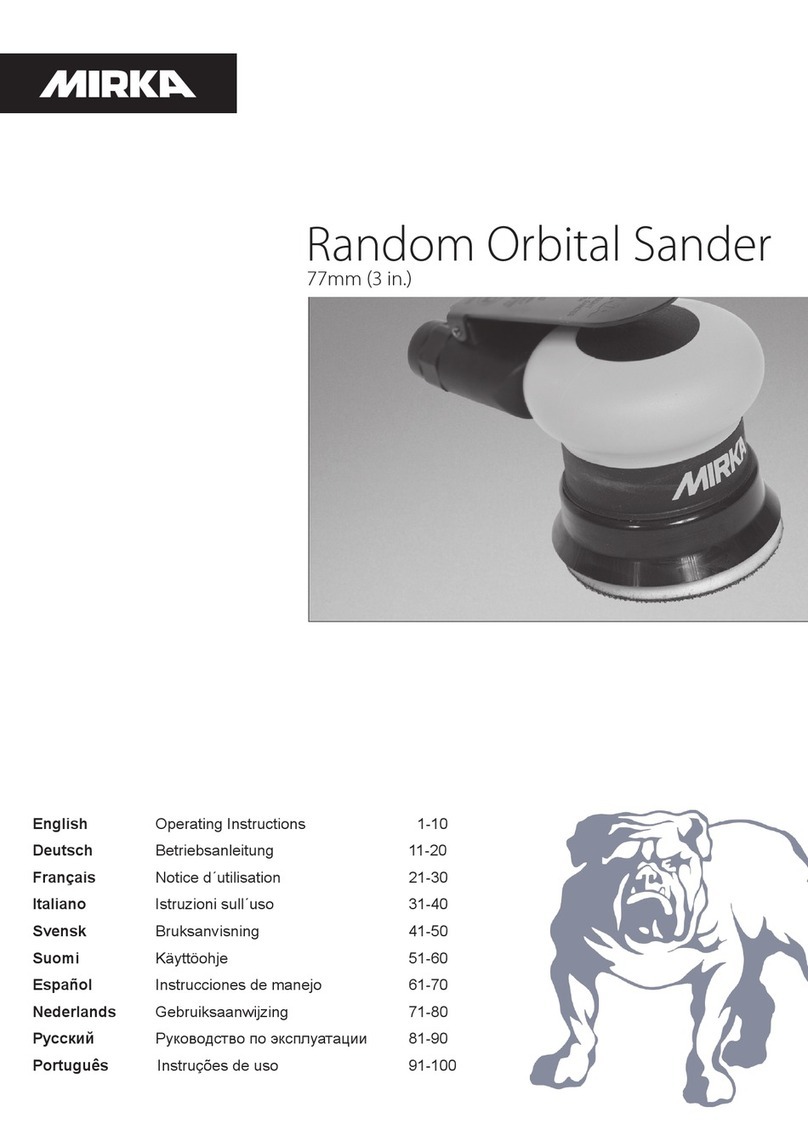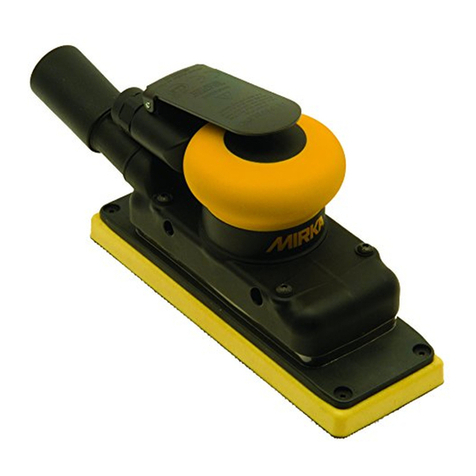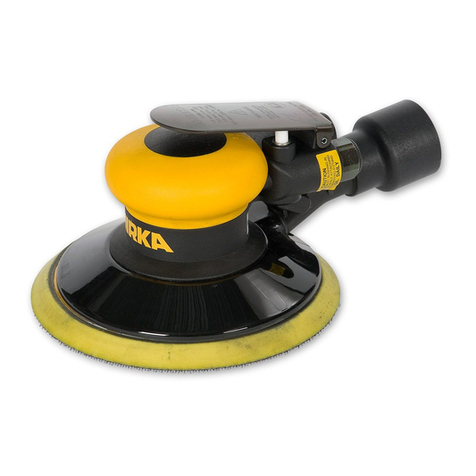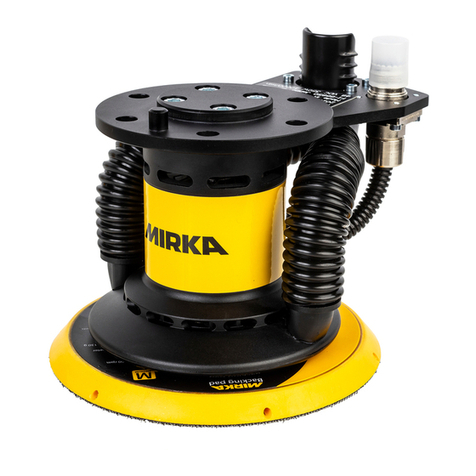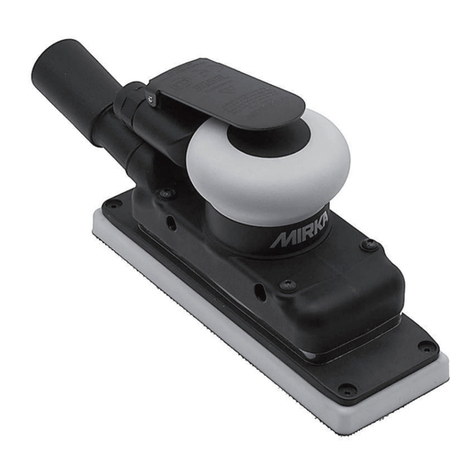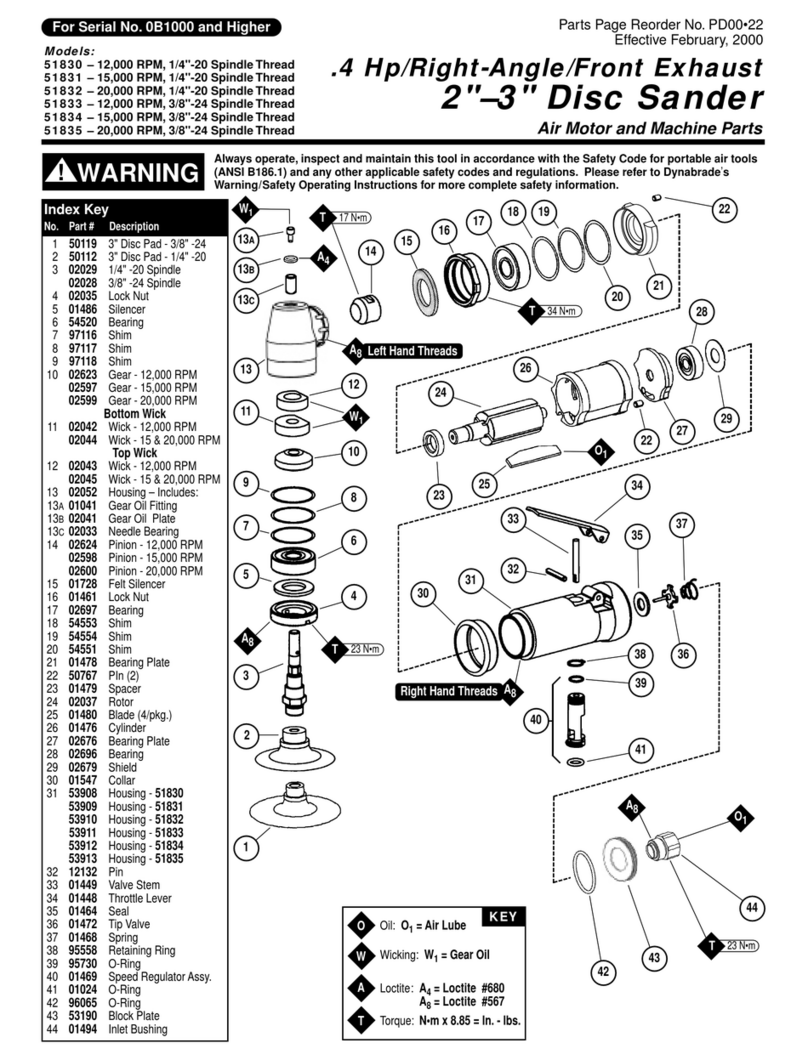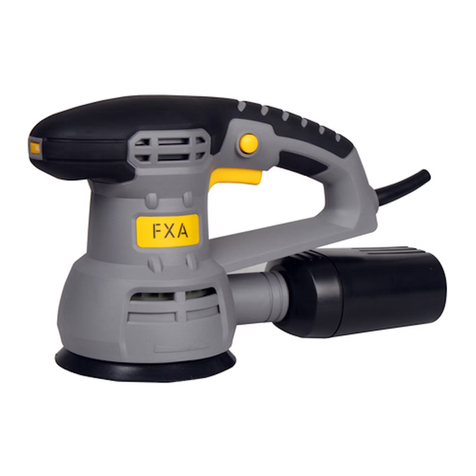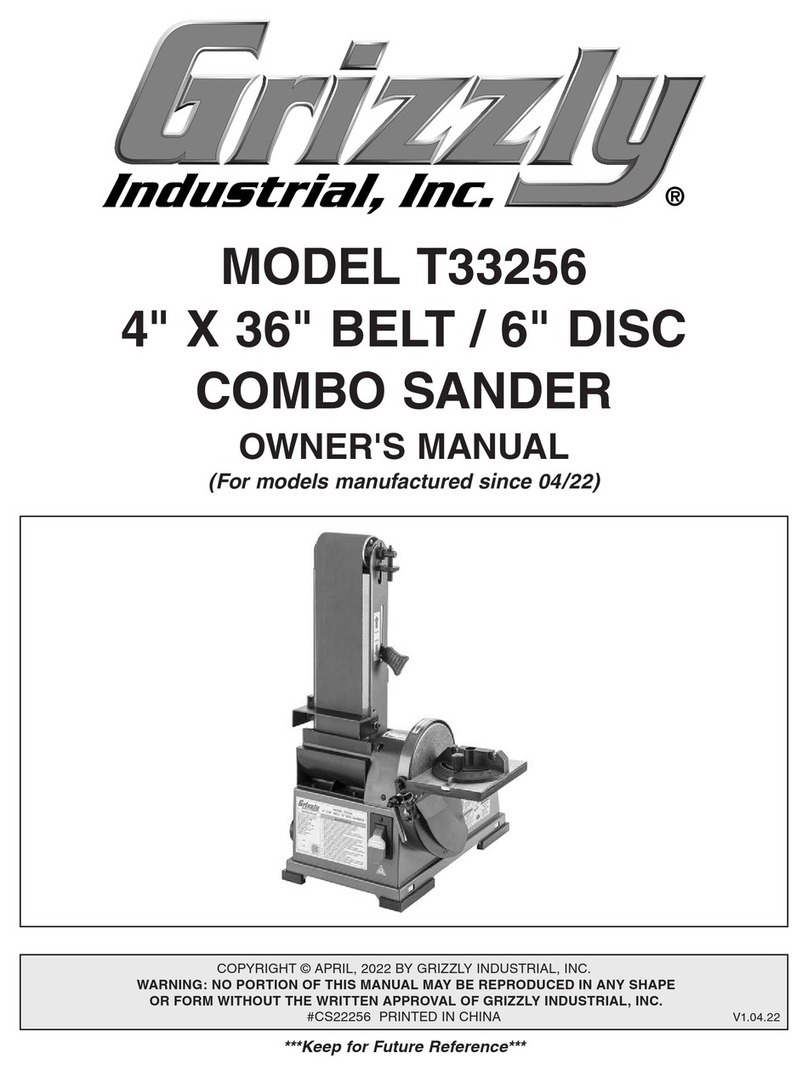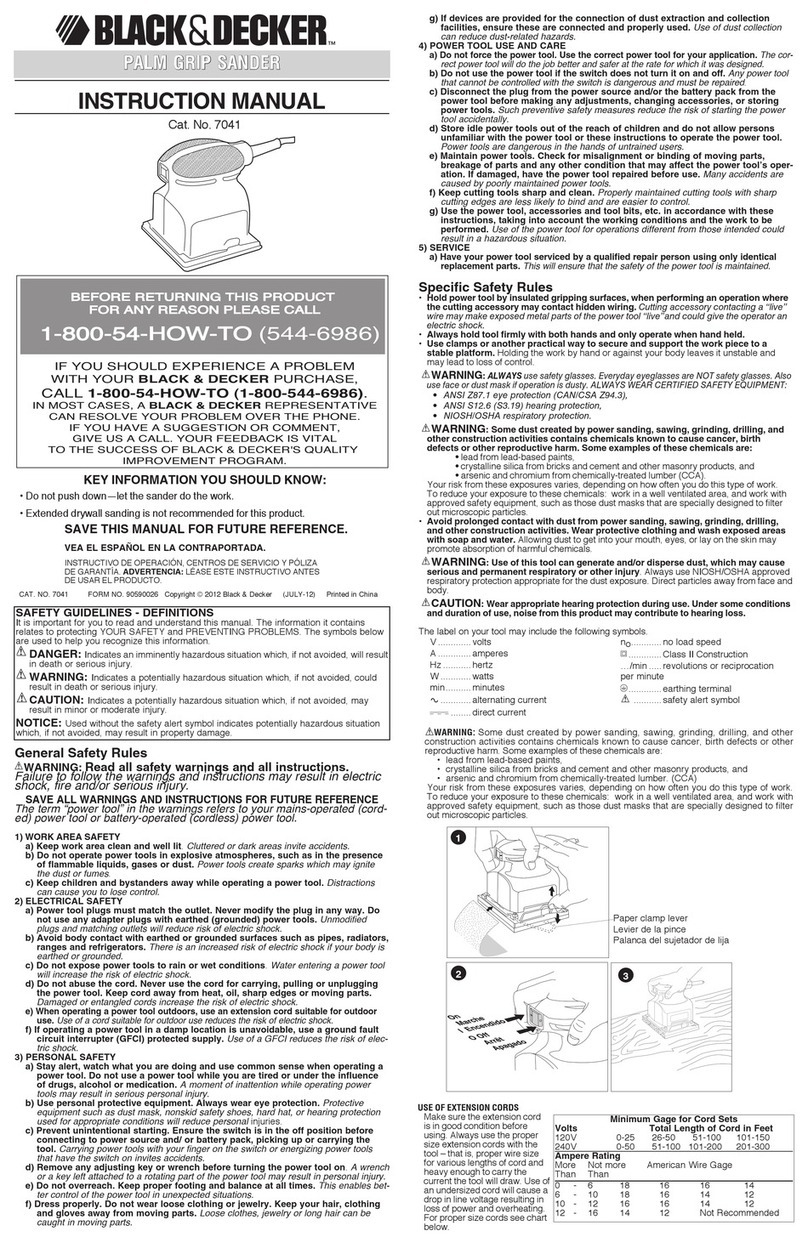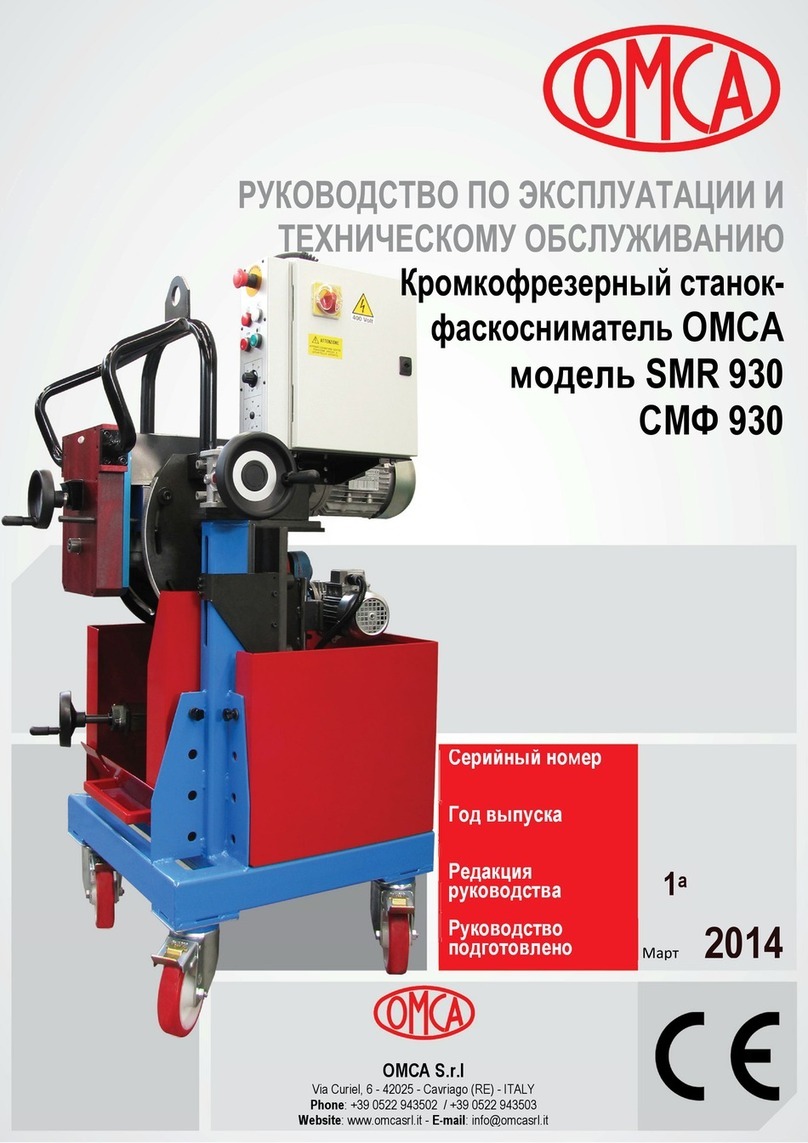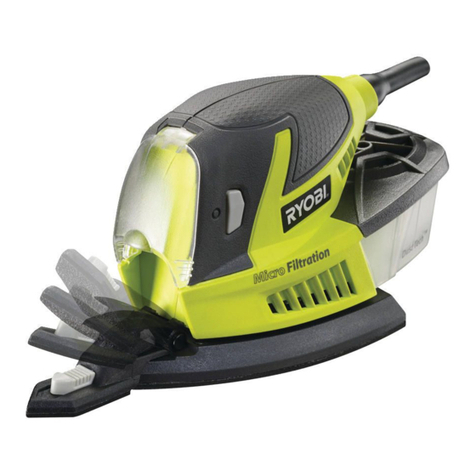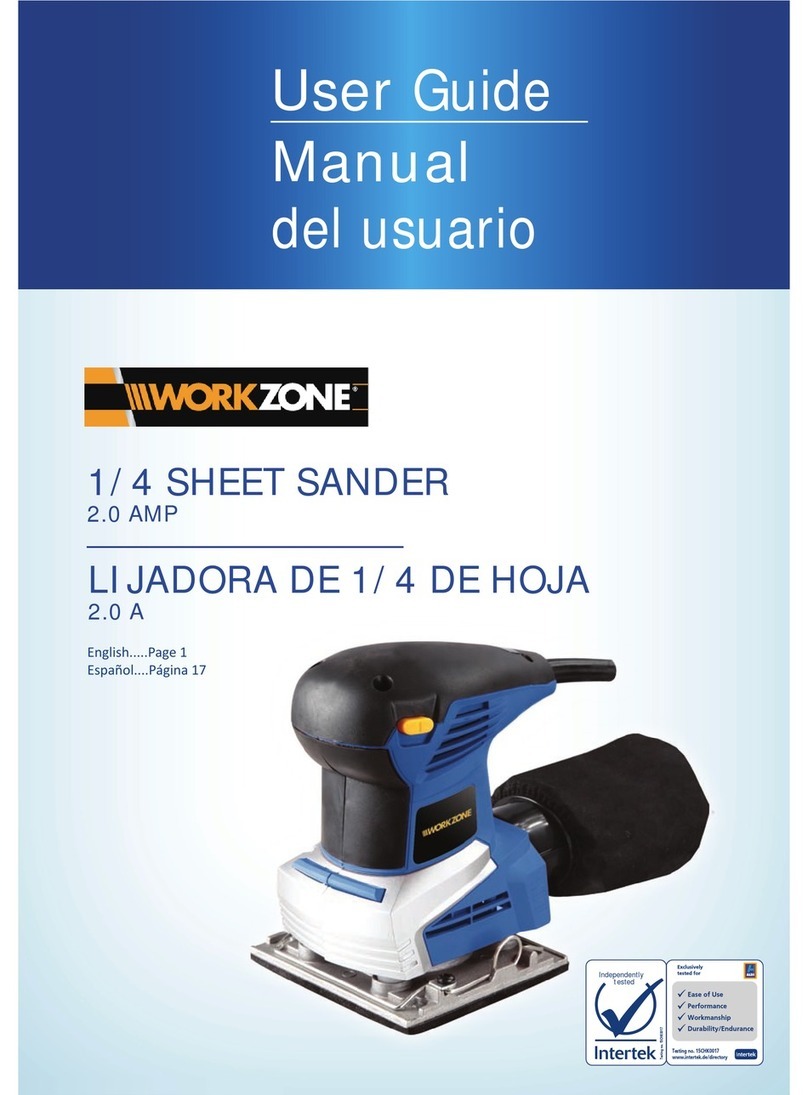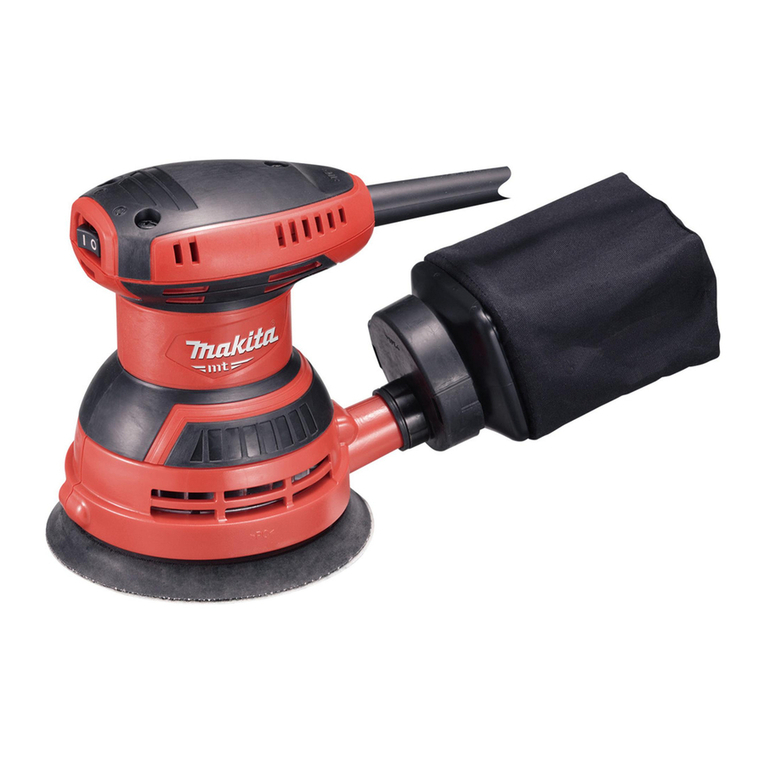8
MIRKA 10,000 OPM
70 mm x 198 mm (3 in x 8 in.)
ORBITAL SANDER
SERVICE INSTRUCTIONS
NOTICE: To receive any expressed or implied warranty, tool must be repaired by an authorized Mirka Service Center. The following
general service instructions provided are for use after completion of the warranty period.
DISASSEMBLY INSTRUCTIONS
Changing Grips:
1. The (27) Grip has two “tabs” that wrap around the body of the
sander under the inlet and exhaust. With a small screwdriver
pick out one of the “tabs” of the Grip, and then continue to go
underneath the grip with the screwdriver and pry the Grip off
the sander. To install a new Grip, hold the Grip by the tabs
making them face outward, align the Grip and slide it under
the (25) Throttle Lever then press the Grip down until it seats
onto the top of the sander. Make sure the two “tabs” seat
under the inlet and exhaust.
Motor Disassembly:
1. Using (47) 2.5 mm Hex Wrench, remove (42) Screws. Slide
the (46) Pad about 15 mm (fore or aft) before removing the
pad from the machine. Lightly secure tool in a vise using
the (MPA0026) T-7 Soft Collar or padded vice jaws with the
bottom of the (43) Pad backing facing upward. Remove the
(45) Screw and four (44) Screws. Remove (44) Screws using
2.5 mm Hex Wrench. Be careful to observe and collect the
optional (23 or 24) Spacer(s) found between the (22) Spindle
Assembly and the Pad Backing.
2. Take the machine out of the vise and take off the Soft Collar.
Remove the (39) Shroud Seal (if applicable). Remove the
four (34) Screws with the (35) Washers using (47) 2.5 mm
Hex Wrench from the (29) Housing and remove the (41)
Pad Supports. Lightly re-secure the tool in a vise using the
(MPA0026) T-7 Soft Collar or padded jaws with the (12) Lock
Ring facing upward.
3. Unscrew the (12) Lock Ring with the (MPA0025) T-6 Motor
Lock Ring Wrench/Spindle Puller Tool. The motor assembly
can now be lifted out of the (29) Housing.
4. Remove the (1) Retaining Ring from the groove in the (13)
Shaft Balancer and the (4) O-Ring from the (5) Cylinder.
5. Remove the (3) Rear Endplate. This may require setting the
Rear Endplate on the (MPA0416) Bearing Separator and
lightly pressing the shaft through the (2) Bearing and Rear
Endplate. Remove the (5) Cylinder and the (6) Rotor with the
ve (7) Vanes from the (13) Shaft Balancer. Remove the (8)
Key from the Shaft Balancer, then press off the (9) Front End-
plate with the (10) Bearing. It may be necessary to remove
the Bearing with a Bearing Separator if it came out of the
Front Endplate and stuck to the shaft of the Shaft Balancer.
6. Remove the Bearing(s) from the Endplates by using the
(MPA0036) T-8 Bearing Removal Tool to press out the Bear-
ings.
7. Remove the (12) Lock Ring from the (13) Shaft Balancer.
Remove the (11) O-Ring from the Lock Ring and set it aside
8. Remove the (71) Dust Shield from the (13) Shaft Balancer.
Shaft Balancer and Spindle Disassembly:
1. Grip the shaft end of the (13) Shaft Balancer in a padded
vise. With a thin screwdriver pick out the slotted end of the
(21) Retaining Ring and peel out.
2. Screw the female end of the (MPA0102) T-12 5/16-24 to M6
x 1P Adapter into the male end of the (MPA0025) T-6 Motor
Lock Ring Wrench/Spindle Puller Tool. Screw the Service
Wrench Assembly into the (22) Spindle Assembly until hand
tight. Apply a gentle heat from a propane torch or hot air gun
to the large end of the (13) Balancer shaft until it is about
100° C (212° F) to soften the adhesive. Do not over heat.
Remove the Spindle Assembly by using the slider to give
sharp outward blows to the Spindle. Allow the Spindle and
Shaft Balancer to cool.
3. Remove the (17) Retaining Ring from the (22) Spindle As-
sembly. Use the (MPA0416) Bearing Separator to remove
the (18) Bearing, (19) Shim, (72) Dust Shield and the (20)
Washer from the Spindle Assembly.
4. The AirSHIELD™ components are held in place by the light
press t of the (16) Retainer. These components can be
damaged during removal and may need to be replaced if
removed. To remove the Retainer, use an o-ring pick or a #8
sheet metal screw to grip and pull out the Retainer. Remove
the (15) Valve and (14) Filter from the bore in the (13) Shaft
Balancer. If the Retainer and Valve were not damaged, they
can be reused. However, the lter should be replaced on
re-assembly.
Housing Disassembly:
1. For Non-Vacuum (NV) and Central Vacuum (CV) machines
follow steps A – C below (unless otherwise noted). For Self
Generated Vacuum (SGV) machines disregard steps A – E
and move onto F.
A. Unscrew the (50) Mufer Housing from the (29) Housing.
B. Remove the (48) Mufer from the cavity of the (50) Mufer
Housing.
C. Remove the (49) Plate and second (48) Mufer from the
exhaust port of the (29) Housing. For non-vacuum machines,
move onto step 2. For central vacuum machines, move onto
D – E.
For CV exhaust machines:
D. Remove the (66) Screw, (65) Washer and (64) Nut.
E. Press downward on the swivel end of the (62) Ø 1 in./28 mm
SuperVAC™ CV Swivel Exhaust Assembly or the (63) Ø ¾
in./19 mm SuperVAC™ CV Swivel Exhaust Assembly releas-
ing the tab on the end of the exhaust assembly from the (40)
CV/SGV Shroud. Move on to Step 2.
For SGV exhaust machines:
F. Unscrew the (56) SGV Retainer with an (MPA0849) 8 mm
Hex Key Wrench. Remove the two (55) O-Rings. Take off
the (57) Ø 1 in./28 mm SGV Swivel Exhaust Assembly or the
(58) Ø ¾ in./19 mm Hose SGV Swivel Exhaust Assembly.
Continue with Step 2.
2. Unscrew the two (37) Screws from the two (38) Shrouds or
the (38) Shroud – (40) CV/SGV Shroud. Be sure that the (36)
Threaded inserts do not fall out. Remove them from the (29)
Housing.
3. Place the (32) Speed Control to the midway position and
remove the (33) Retaining Ring. The Speed Control will now
pull straight out. Remove the (31) O Ring from the Speed
Control.
4. Unscrew the (54) Inlet Bushing Assembly from the (29) Hous-
ing. Remove the (53) Spring, (52) Valve, (51) Seat and (30)
Valve Stem.
5. Press out the (26) Pin from the (29) Housing and remove the
(25) Lever then press out the (28) Sleeve.
